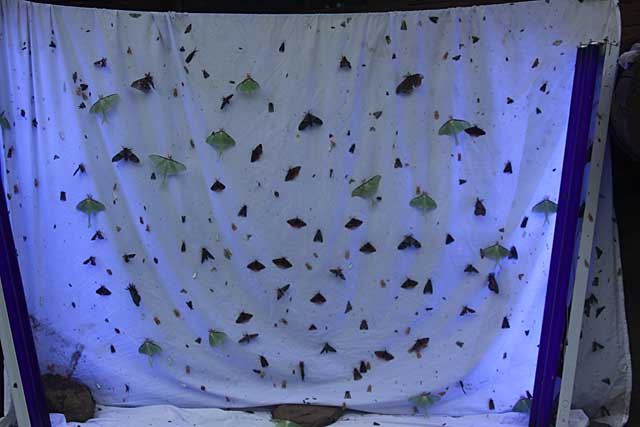Cook County, Minnesota
Sphingidae

|
|
Created/dedicated as per personal communication with Ian Miller; July 29, 2013 Updated as per James P. Tuttle's The Hawk Moths of North America; July 29, 2013 Updated as per BAMONA; July 29, 2013 |

Ian writes, "Bill,
"Feel free to use this photo as you wish. This was from July 8th in Cook County, MN. The sphinx liked settling between the cabin and the sheet so many are not visible in this photograph. I believe the new moon occurred during this night.
"The sphingidae species include: Smerinthus cerysi, Smerinthus jamaicensis, Paonias myops, Paonias excaecatus, Darapsa myron, Pachysphinx modesta, Sphinx poecila, Sphinx kalimae, Sphinx canadensis, Hyles gallii, and Hyles euphorbiae.
"I have Hyles gallii larva on fireweed right now (July 22, 2013); Smerinthus cerysi on birch willow and aspen and Sphinx kalmiae on lilac (also on white ash).
"I did manage to obtain half dozen Hyles euphorbiae ova but have no leafy spurge, and they declined flowering spurge fireweed and primrose. Figured I would attempt some other hosts for fun.
Thirty-seven Sphingidae species are listed for Minnesota on the BAMONA website. Not all of the species are reported or anticipated in Cook County (only Hemaris diffinis is reported on BAMONA as of July 29, 2013). It is hoped that this checklist, with the thumbnails and notes, will help you quickly identify the moths you are likely to encounter.
A "WO" after the species name indicates that I have no confirmed reports of this species in your county, but I (William Oehlke) expect that this moth is present or might be present. I have included many species not on the USGS list for Minnesota; I believe they are or might be present.
A "BAMONA" indicates the moth is reported in Lepidoptera of North America, #1. Distribution of Silkmoths (Saturniidae) and Hawkmoths (Sphingidae) of Eastern North America, an excellent little booklet available through Paul Opler, or on BAMONA website.
Please help me develop this list with improved, documented accuracy by sending sightings (species, date, location), preferably with an electronic image, via email to Bill Oehlke.
Please also send your sightings to BAMONA, an excellent on-line resource.
Visit Cook County Sphingidae Larvae: Caterpillars; Hornworms
Visit Minnesota Catocala: Underwing Moths
If you are travelling, you can find active Sphingidae checklists for all countries in North, Central, and South America and the Caribbbean via the links at
North, Central, South American Sphingidae checklists
Sphinginae subfamily
Smerinthini Tribe:
Macroglossinae subfamilyDilophonotini tribe:
Macroglossini tribe:
|
Enjoy some of nature's wonderments, giant silk moth cocoons. These cocoons are for sale winter and fall. Beautiful Saturniidae moths will emerge the following spring and summer. Read Actias luna rearing article. Additional online help available.
Use your browser "Back" button to return to the previous page.
This page is brought to you by Bill Oehlke and the WLSS. Pages are on space rented from Bizland. If you would like to become a "Patron of the Sphingidae Site", contact Bill.
Please send sightings/images to Bill. I will do my best to respond to requests for identification help.
 Show appreciation for this site by clicking on flashing butterfly to the left. The link will take you to a page with links to many insect sites. |
I very much appreciate all the many images that have been sent to me, or of which I have been granted permission to copy and post from other websites. All images on this site remain the property of respective photographers.
If you would like to contribute to the maintenance of this website by sending a contribution to
Bill Oehlke
Box 476
155 Peardon Road
Montague, Prince Edward Island, C0A1R0
Canada
your donation would be much appreciated and would be used for
1) paying for webspace rental;
2) paying for computer maintenance and software upgrades;
3) purchases of additional text reference material (journals and books) in anticipation of expanding the site to a worldwide Sphingidae site;
4) helping to pay my daughter's tuition (completed spring 2013); with anything left over going to humanitarian aid.
If you are mailing a check from USA, please use $1.10 postage ($1.25 is 2018 rate so check with post office as rates seem to be rising annually). Donations can also be made through Paypal via the button below.